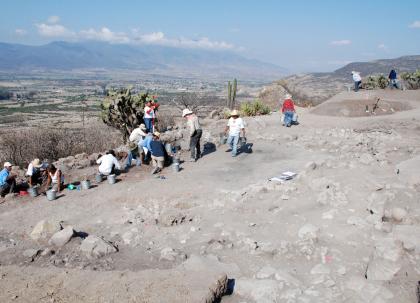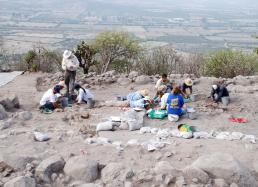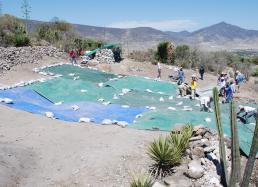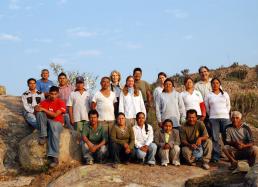7: The Hardest Day of the Season
When the field season began, Terrace 57 didn't look very different than other slopes or terraces at the Mitla Fortress. The terrace appeared as a flat area spottily covered with pieces of rock and ceramic fragments, bordered by thorny, scrubby vegetation especially on the front (down slope) side, splotched by giant ant hills in select spots, and covered by a thin mat of grass.
Now, after two months of clearing, laying down a grid, carefully removing sediments (context-by-context), and steadfastly documenting what we found both graphically and digitally, the space has taken on a great deal more meaning (see above photo.) This place now has greater significance not just for us, the archaeologists (now including Alicia, who recently arrived), but for our Mexican crew as well. No one was more affected than our night watchman, Lorenzo, who spent more time near Terrace 57 these past two months than anyone else, staying up at the excavations every night and on weekends.
But the work and the Terrace 57 locality also clearly took on meaning for the rest of the crew, who tried the best they could to cover the excavated area with tarps each afternoon to guard against the potential for rain (fortunately we had little), and then lifted these same plastic sheets each morning to start the work day (see Photos #1 and #2 below.) After that, for two months, eight hours or more Monday through Friday, we executed our research program in this defined space and its surroundings, each with our own duties and responsibilities.
All of us also shared together in the excitement of important discoveries made during the excavations, be they artifactual (such as a more complete urn that we found in the arm of a burial) or architectural (such as following a structure wall or a patio banquette). We also sat together and chatted near the terrace during our midday breaks and sometimes even partitioned the sandwiches and tacos that emerged each noon from rope bags and synthetic backpacks.
After painstakingly exposing the excavation area level by level, documenting how the prehispanic occupants of Terrace 57 used this space, we also shared in its consolidation, taking steps to enhance preservation. Then, in the last days of working together, we once again covered the exposed prehispanic surface with sediment (for its protection), as per authorization from the National Institute of Anthropology and History, returning the space to something like it looked like when we began.
After two months of working together, I generally find that the hardest day of the season for me is the final day of fieldwork before we begin our time in the lab. That's the last day that our whole team is together and the final day of project work for many members of our Mexican crew. The day is bittersweet because it marks the disassembling of our team, and it means that I no longer can offer regular work for these local people, who can use it.
Of course, on the other side as project director, some of my worries are mitigated at the close of daily fieldwork. No longer can heavy downpours be such a threat to our goals, nor do we have to obsess about having just the right combination of bills in pesos each week to pay 18 local workers in cash (exact change). Of course, this last field day also means that we've accomplished our principal field goals and can return to the lab with both many questions to pursue and myriad kinds of information to address these issues.
When in the field, every Friday at the close of the workday, I generally meet briefly with each member of the crew as I deliver their weekly wages. Now, as the field part of the season ends, I repeat this face-to-face “ritual.” After decades of excavations in the Valley of Oaxaca, this year’s Mitla crew was one of the best local groups that we've put together and had the chance to work with. Many members of our 2010 crew are veterans of 2009, and we hope the majority are able to return to our study next season (see Photo #3 below.)
The work ethic and camaraderie of the crew made this last day in the field even more difficult for me this year. But solace can be taken in the refrain, Hasta el año que viene (“Until the coming year”). We're also planning our second annual celebratory get-together with the crew, which takes place on Saturday, a few days after the end of this year’s fieldwork.
Word of the Day: torta, which means “sandwich.”
Gary





